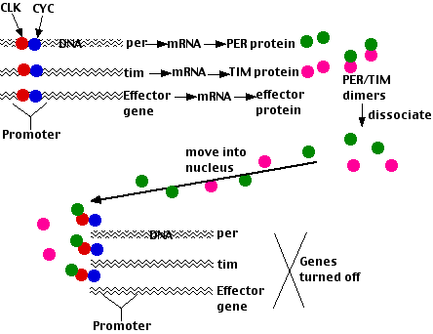CIRCADIAN RHYTHM IN DROSOPHILLA
A number of genes in Drosophila are turned on when the animal is exposed to light:
The Mechanism
Setting the Clock
Even without any external cues (e.g., alternating light and dark), the cycles persist although they tend to drift away from environmental time.
- effector genes whose products mediate the animal's responses (e.g. hatching or molting)
- clock genes whose products regulate the circadian clock. Two key members of this group are:
- period (per)
- timeless (tim)
- CLOCK encoded by the gene clock (clk) and
- CYCLE encoded by the gene cycle (cyc)
The Mechanism
- The PER and TIM proteins (synthesized on ribosomes in the cytoplasm) form dimers.
- When the concentration of these gets high enough (early evening), they dissociate and are transported into the nucleus.
- Here PER
- binds to the CLK/CYC transcription factors, removing them from the promoters of the genes they activate; thus shutting off transcription. Because these genes include per and tim, the result is a negative feedback loop; that is, the product of the per gene inhibit its own synthesis (as well as that of tim). Just as the heat of a furnace turns — through the thermostat — its own production off, so a rising level of PER/TIM dimers turns off further synthesis of them. As the level then falls, this inhibition is lifted and PER/TIM activity begins anew.
- turns on clock gene expression.
- The time required for the different effects results in the levels of PER/TIM and CLOCK oscillating in opposite phases with a circadian (~24 hr) rhythm (figure).
Setting the Clock
Even without any external cues (e.g., alternating light and dark), the cycles persist although they tend to drift away from environmental time.
- Under natural conditions, the clocks are precise.
- This is because they are "set" (synchronized) by environmental cues, of which light is one of the most important.
- Light (blue) is absorbed by the protein cryptochrome (CRY).
- This causes an allosteric change in its conformation enabling it to
- bind to TIM and PER.
- This causes TIM and PER to break down (in proteasomes) ending their inhibition of gene transcription.
- If this happens when PER/TIM levels are rising (late in the "day"), it sets the clock back.
- If it happens when PER/TIM levels are declining (late in the "night"), it sets the clock ahead.

